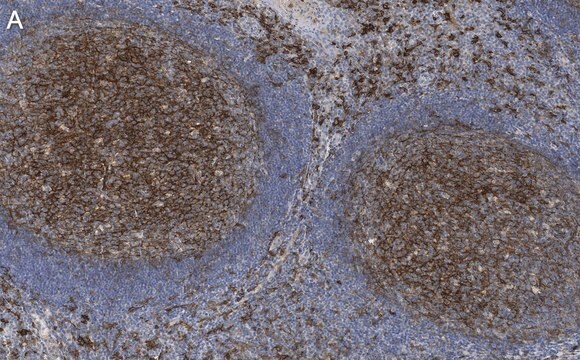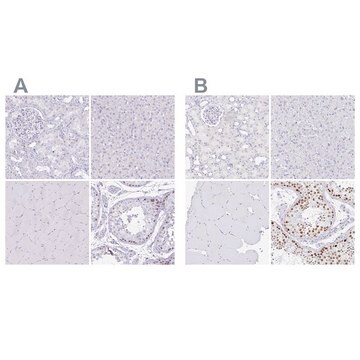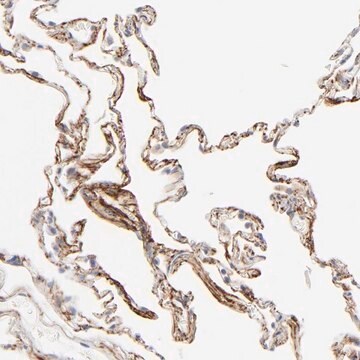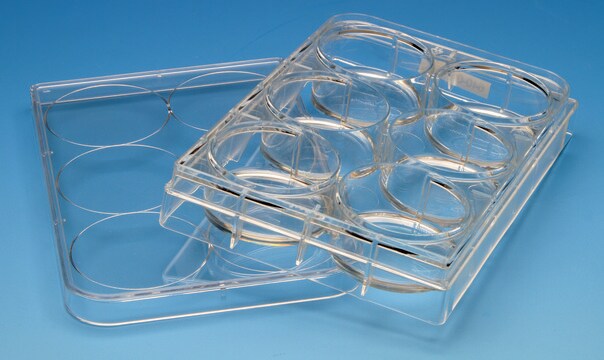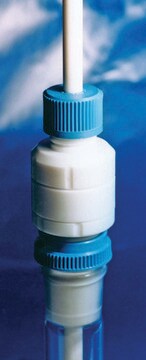MAB1692
Anti-Dystrophin Antibody, mid-rod, clone 6D3
culture supernatant, clone 6D3, Chemicon®
Sinónimos:
Anti-BMD, Anti-CMD3B, Anti-DXS142, Anti-DXS164, Anti-DXS206, Anti-DXS230, Anti-DXS239, Anti-DXS268, Anti-DXS269, Anti-DXS270, Anti-DXS272, Anti-MRX85
About This Item
WB
western blot: suitable
Productos recomendados
biological source
mouse
Quality Level
antibody form
culture supernatant
antibody product type
primary antibodies
clone
6D3, monoclonal
species reactivity
mouse, canine, human, rabbit, rat
manufacturer/tradename
Chemicon®
technique(s)
immunohistochemistry: suitable
western blot: suitable
isotype
IgG2a
NCBI accession no.
UniProt accession no.
shipped in
dry ice
target post-translational modification
unmodified
Gene Information
human ... DMD(1756)
Specificity
STAINING PATTERN:Light microscopy: continuous rim of labeling at the periphery of muscle fibers.
E.M. gold: close to the cytoplasmic face of the plasma membrane.
Western blotting: strong double bands at approximately 400 kD plus metabolites of lower molecular mass.
Immunogen
Application
undiluted - 1:20. Not recommended for use on paraffin embedded tissue.
EM Gold (Light fixation with 2% formaldehyde + 0.001% glutaraldehyde for 1 hour. 2.3M sucrose used as cryoprotectant.): use undiluted. 90 minute incubation at 25°C.
Western blotting: use 1:100-1:250.
Optimal working dilutions must be determined by the end user.
Protocol for Immunohistochemical use of MAB1692
1) Freeze muscle blocks in isopentane chilled in liquid nitrogen.
2) Cut 4 μm to 10 μm sections and air dry on slides coated with 0.5% gelatin containing 0.05% chrome alum.
3) Slides may be stored at -70 °C wrapped in cling film until required. If stored sections are used, allow sections to equilibrate to room temperature before unwrapping and proceeding.
4) Apply a 50 μL aliquot of primary antibody to sections (unfixed). Incubate for 1 hour at room temperature or 37°C.
5) Wash sections 3 x 10 minutes in phosphate buffered saline.
6) Apply a 50 μL aliquot of labeled second antibody. Incubate for 60 minutes at 25°C.
7) Wash sections 3 x 10 minutes in phosphate buffered saline.
8) Mount fluorescent sections in aqueous mounting media or visualize peroxidase label (DAB). Dehydrate, clean and mount peroxidase labeled sections for permanent preparations.
Metabolism
Muscle Physiology
Physical form
Storage and Stability
Analysis Note
POSITIVE CONTROL: Snap frozen normal human or rat striated muscle.
Legal Information
Disclaimer
¿No encuentra el producto adecuado?
Pruebe nuestro Herramienta de selección de productos.
Optional
Storage Class
12 - Non Combustible Liquids
wgk_germany
WGK 2
flash_point_f
Not applicable
flash_point_c
Not applicable
Certificados de análisis (COA)
Busque Certificados de análisis (COA) introduciendo el número de lote del producto. Los números de lote se encuentran en la etiqueta del producto después de las palabras «Lot» o «Batch»
¿Ya tiene este producto?
Encuentre la documentación para los productos que ha comprado recientemente en la Biblioteca de documentos.
Nuestro equipo de científicos tiene experiencia en todas las áreas de investigación: Ciencias de la vida, Ciencia de los materiales, Síntesis química, Cromatografía, Analítica y muchas otras.
Póngase en contacto con el Servicio técnico

